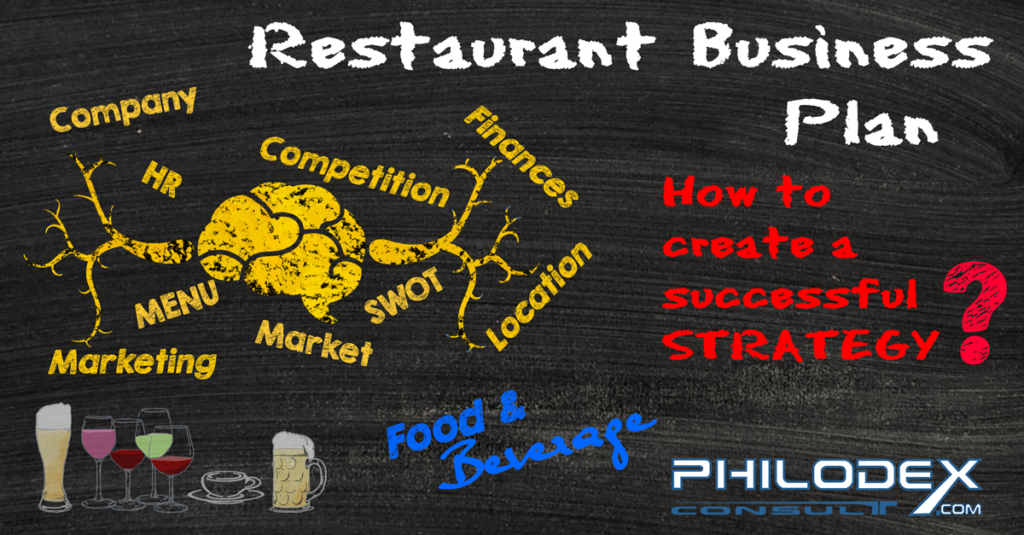» Main Topics of your Restaurant Business Plan
After you have established your ideas, discovered your WHY, and identified your objectives, you should be able to put your gut thoughts and beliefs into words and onto paper.

Contact me if you have any questions to that subject!
|
Executive Summary
Vision, Mission, Values, Concept, Costs, ROI
Your business idea, your intention, turnover and profit prospects, finance requirements, risks, what you did up to now, today’s situation.
In any business strategy, the executive summary is the first bit. It introduces and sums up your whole concept. The major parts of what will be covered throughout the business strategy should be introduced in this section. It should grab the reader’s interest and persuade them to continue reading.
Company Overview
Description, Elements, Ownership, Business Structure
Description of the operation, your products and services, why the market needs exactly your business, business life cycle, legal protection, technology, guests, capacities, suppliers, production facilities.
Begin explaining the high-level features of the prospective business in this part. The firm overview describes the ownership structure, location, and business idea. Create a vision for the guests experience. Describe the company. Determine your restaurant’s service style, appearance, layout, theme, and all other distinguishing features.
Market
Market Area, Spending Behaviour, Demographics
Market analysis, capacity, potential, strategy, targeted customer groups, trends, entrance barriers, growth of market
The restaurant sector is a very competitive one, so establishing your specialty is critical. What will set your operation apart? You should have a good concept of who your restaurant will appeal to and who you hope will return. Describe your target market and how it compares in terms of diner demographics, traits, and behaviours to the restaurant industry as a whole.
Competitors
Concepts, Items, Prices, Promotions, Growth
Competitors, their position in the market, their strength and weakness, products, characteristics, competition advantages, strategy of the competitor(s), co-operations, appearance in the market
One of the most difficult hurdles facing the restaurant sector is fierce competition. Competition, on the other hand, might be beneficial to your restaurant business by bringing in new consumers.
Marketing Plan
Website, Social Media, Google, Email, Events, Sponsorship, Frequency, Content, PR
Your segment in the market, selling arguments (quality, design, price), your target markets (geographic, demographic, etc.), customer groups
The food and beverage industry is becoming increasingly competitive. As a result, marketing is an important part of drafting a restaurant business plan. Prior to beginning, you should have a clear idea of your market approach. Make a marketing budget for both online and offline campaigns. A percentage of every coin you earn should go into marketing.
Menu
Items, Design, Prices, Calculation, Specials, Food, Beverages
Menu sample, design, CI, items, content, structure, wording, calculations, engineering – matrix of products (question marks, stars, etc.)
Because the menu is the most visible representation of a restaurant’s brand, it should be more than just a list of things. Include your logo and create a mock-up menu design. It goes without saying that it is the heart of your restaurant strategy. Business owners typically agree that if you provide outstanding cuisine, your restaurant shall be able to endure the competition. As a result, the restaurant business plan must include what you want to offer.
Team, Staff, HR
Kitchen, Service, Bar, Stewarding, Office, Administration, Consultants And Management
HR, recruitment, OrgChart, job profiles, job descriptions, SOPs, policies, training, workflow, CVs, references
You will need an overview of how many workers and what jobs you will have to employ to run your restaurant, from waiters, chefs, to management to partners. Pay special attention to your management team’s makeup and structure. These are the people who will determine whether you succeed or fail. Partners and investors will want to see that you have carefully considered how your restaurant will operate and who will execute your strategy.
Location, Production
Area, infrastructure, neighbourhood
Technology, capacities, suppliers, production facilities, logistic, size, cost, advantages and disadvantages of locations, the investment needed to maintain and to increase the capacity
Most prospective restaurant owners do not have a precise site in mind when they write and present their business plans, so concentrate on the broad region or city where you want to locate the restaurant and why you choose it. Include items like the local economy’s growth, big citywide events, and neighbouring infrastructural projects. Compare the current market conditions to the market you want to reach.
SWOT
Strength, Weakness, Opportunity, and Threats
A SWOT Analysis should be included in your Restaurant Business Plan since it will assist you in identifying internal and external elements that will affect the restaurant’s future. It not only warns you about what may go wrong and your vulnerabilities, but it also offers you a complete breakdown of your strengths and possibilities so you can make better use of them.
Financial Analysis
P&L, Revenue Projection, Investments, Prime Cost, Operational Cost, Budget
One of the last sections of a business strategy is usually the financial analysis. Investors demand a summary of how you plan to spend their money in the first year, as well as a comparison of estimated expenditures and income. You should make sure to incorporate a few key items in this area.
What could/should (but not limited to) be included into the business plan:
- Investment Strategy
- Profit and Loss (P&L) Statement Proposed
- Analysis of Break-Even
- Cash Flow Forecast
- Where the money comes from (capital)
- Where Does Your Money Go? (expenses)
- Capital investments and costs
- Expenses of Operations
- Cost Projection
- Projection of Revenue
- Per capita income
- Budgets
- ….
Rate me (Google Rezension)
Our F&B Consulting service is here for you at any time!
Questions? Doubts? How does that work?
|

